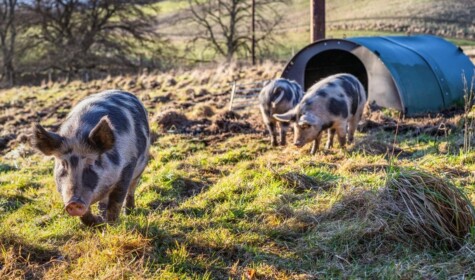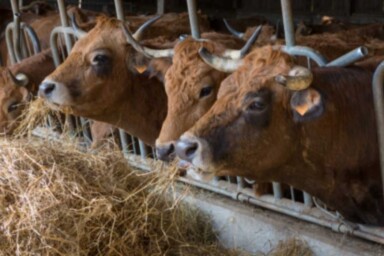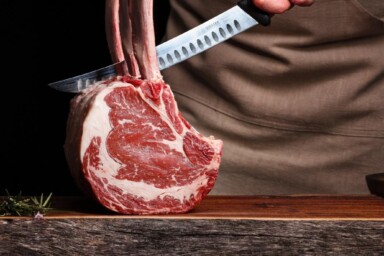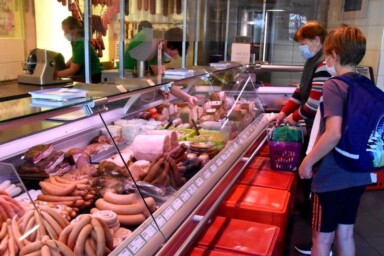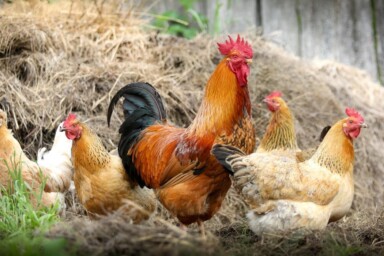Right before the closing plenary of the ORFC 2022, farmers and experts discussed the need for more local abattoirs and access to butchery for farmers across the UK in the session Supporting Local Meat Supply Chains: What Next for Small Abattoirs.
It wasn’t the first time the issues were raised since the 2018 Sustainable Food Trust report, A Good Life and a Good Death, established the facts: across the UK small abattoirs are closing and that has huge implications for farm profitability and animal welfare. Without a local slaughter facility, farmers can’t sell their meat directly and they often have to transport their animals for slaughter over long distances. Such trips are extremely stressful for the animals, in particular those which have known nothing but life on a pasture, and it is stressful for the farmers who have cared for their animals, often from birth, and don’t want them to suffer.
Today, only 60 abattoirs are left in the UK – and that number is likely to decline further. So, what can be done?
With seven speakers and just an hour for what is a huge and important topic, contributions needed to be kept brief. Patrick Holden, the founder and director of the Sustainable Food Trust, is also an organic dairy farmer and knows the issue first hand. Local abattoirs should be a vital part of the Government’s agricultural transition plan and ‘the path to sustainable farming’. In Holden’s opinion, a 30 mile journey to an abattoir is the maximum any animal should endure.
Horns and hides
If they had access to small, local abattoirs, more farmers would keep rare breeds, argued Tom Blunt from the Rare Breeds Survival Trust (RBST). Holstein cows may be capable of producing the highest milk yields and breeds such as Black Angus or Herefords manage to convert feed into meat in record time, but they are very intensively bred and therefore very vulnerable. We need to keep rare breeds not least because of their genetic variety. But no farmer can afford to raise animals for the fun of it. If we want to keep it, we must eat it – and for that small abattoirs are needed.
Why small? John Mettrick, a master butcher, jumped in to lead the discussion. Large abattoirs depend on high throughput, he said, small abattoirs add value. That’s why large abattoirs are highly specialised; they accept only one species of animal and only in larger numbers. Small abattoirs will process cattle, pigs, sheep and goats, but are forced to deal with the disproportionately large amount of paperwork that becomes necessary when farmers deliver a small number or even one individual animal for slaughter, he said. Tom Blunt mentioned another issue: farmers who keep rare breeds need to make use of the whole animal, including the ‘fifth quarter’. Horns and hide of rare breeds have value and only small abattoirs will offer a bespoke service. He quotes a recent survey in which 42% of respondents said that the ‘lack of a suitable abattoir’ was one of the main barriers to keeping rare breeds or expanding their business.
Telling the story of animals, their lives and their deaths
Rare breed farmers often market outside of the standard supply chains, they create and find their own markets and that’s what more and more consumers are looking for. At the beginning of the pandemic people started to care more where their food comes from and it’s developed into a real trend, said Blunt.
The increased consumer interest could be an opportunity for the Campaign for Local Abattoirs. The panel agreed that since most people buy meat at a supermarket (which mainly processes meat in huge, industrial slaughter facilities), a gap has opened up: the fact that animals need to be slaughtered is not part of the story of meat anymore. The Sustainable Food Trust report on small, local abattoirs sums it up in the title – a good life and a good death. That’s the story that needs to be told if the public is to support the campaign.
Money is, of course, the other big issue. Small abattoirs deliver exactly what is needed for local food systems to thrive, said Kath Dalmeny from Sustain. These abattoirs should be publicly funded. They provide the ‘green jobs’ the Government wants to create and there should be money to finance them. Since Brexit, Britain no longer contributes to the European Structural and Investment Fund which promotes regional development – the British government now decides where that money goes. But in her discussions with Defra, Dalmeny found that ‘they are not convinced by the scale’ and rather look at ‘high tech green jobs’ that fit into the Government’s push for increased productivity through automation and robotics.
Are mobile slaughter units the solution?
The need to save existing small abattoirs and possibly revive closed ones is ongoing, but in the meantime, farmers are look for other options. Mobile slaughter units could be a really good solution – that’s the theory at least…There is now one prototype of such a unit, and Andy Gray from Elston Farm was able to try it out on his farm. It’s not as simple as parking the unit somewhere and going to work, he said, there needs to be a holding facility, extra chilling space, water, a work space for the vet, toilet facilities and issues such as laundry and waste disposal have to be dealt with, all in accordance with a long list of government regulations. It’s all doable, Gray said, though the huge costs of the slaughter unit remains an issue: it doesn’t make sense for farms with just a few animals per year to slaughter. But at least APHA, the government’s Animal and Plant Health Agency, has softened in their approach and officials have been helpful, said Gray.
Defra’s John Powell addressed some of the concerns. The mobile abattoir pilot has taken longer than expected, he said, but if the trials were to be successful, which he was sure they would be, the model could be replicated. However, changes in the law would be necessary and that would take time. Powell said he saw clear opportunities for small abattoirs that would provide local food for local people and could be ‘a catalyst for growth’. Powell said he and his team were looking at the issues but with post-EU funding now coming on line, an abattoir project would have to demonstrate the direct benefit for producers.
A clear message of ‘no’
One might have come away from the session with some cautious optimism – until catching up with what was happening at the other Oxford Farming Conference where Defra secretary George Eustice had been speaking earlier. ‘Eustice rules out government funding for abattoirs in England’ read the headline in Farmers Weekly. ‘Defra officials had carried out a lot of analysis on this topic,’ Farmers Weekly quoted the minister ‘but when they looked at the situation in England, the minster said they found there was a “fairly good, fairly even distribution” of abattoirs – notwithstanding the fact that there has been some consolidation in recent years.’
The Campaign for Local Abattoirs will continue, but don’t expect any quick fixes.
